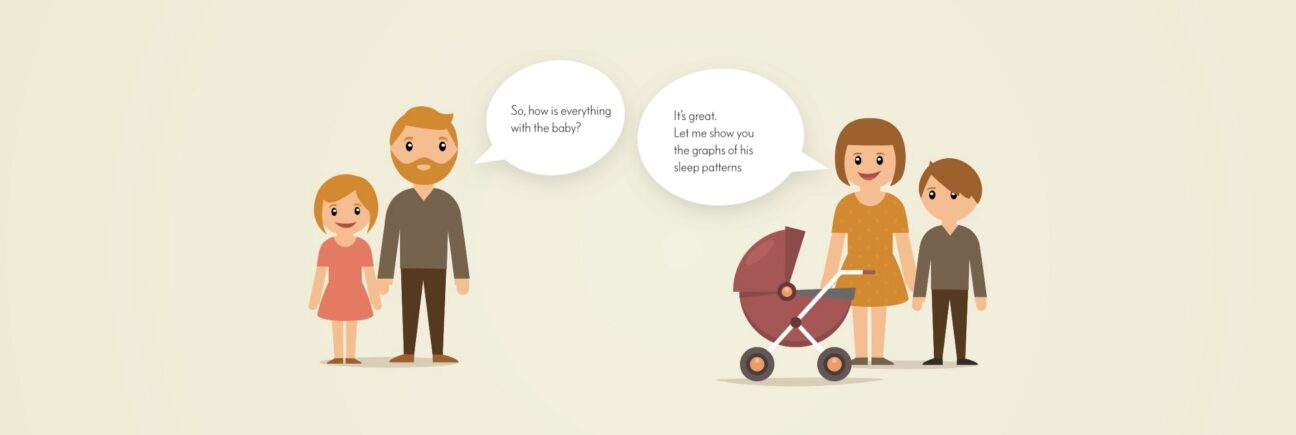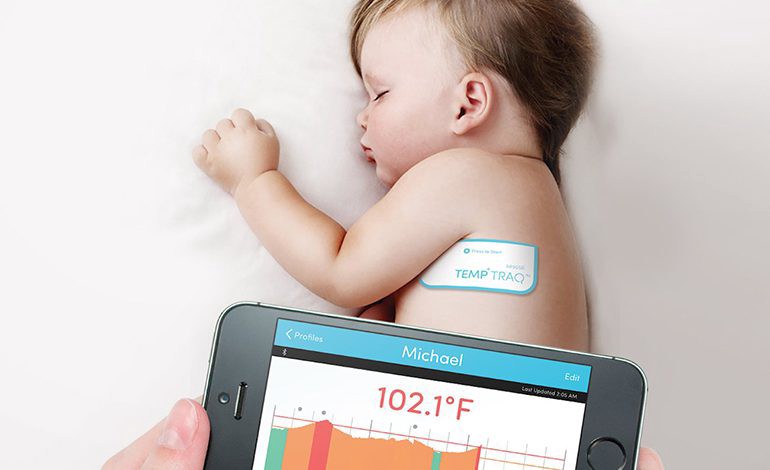If we spoke about children in the same way smart products do, we would have some pretty awkward conversations.
Being a parent is tough work. It is getting up in the middle of the night to comfort your baby or scared toddler who repays you the next day by throwing a tantrum in a crowded supermarket, or by throwing milk all over the floor in the middle of dinner preparation.
Being a parent is also worrying a lot. Does my baby eat enough? Why isn’t he sleeping better? Is it normal for my three-year-old to behave like a teenager? And then when they are teenagers, worrying about what they are doing 15 minutes past curfew.
In this light, it can be challenging to think of more noble efforts than trying to ease the workload — and worry-load — for hardworking parents?
And that is precisely what some technology firms are trying to do with a range of smart products targeted towards parents and children. For instance, the intelligent thermometer TempTraq seeks to provide rest for children and peace of mind for parents. Or the smart baby onesie, Mimo, wants parents to be able to shake the uneasy feeling of whether or not their babies are sleeping soundly.
On the surface, it’s hard to argue against the empathic intentions of these companies. But are products like these really what parents need to feel better? As a UX designer — and father — I don’t think that they are.
Most IoT products (Internet-of-Toddler, that is) use advanced sensors and intriguing new technologies to help parents monitor, track, visualize, and send alerts about their children. In other words, the products help parents keep track of their children by specific measurements and quantifiable metrics. But I’m not convinced that is what will really make us feel less overwhelmed about parenthood.
Let me elaborate by introducing you to three smart products. It’s important for me to say that my ambition is not to critique these particular products, but rather to use them as examples of my general concerns about the direction of many smart products.
TEMPTRAQ: Wearable thermometer
The TempTraq is a flexible “band-aid”-like wearable you can put directly on the child’s skin. This makes it less uncomfortable to check if your child has a fever, and you do not even have to wake it.
The TempTraq smart, wearable thermometer.
Besides allowing parents to check if their child has a fever, another feature of TempTraq is that you can connect it to your smartphone and continuously monitor your child’s temperature. This way, you can go to bed with ease of mind knowing that TempTraq will alert you if you need to worry.
Naturally, the immediate thought of a full night’s sleep is always appealing. Still, I think staying up the entire night to care for your little one can be valuable in developing your relationship with your child — and in developing your self-esteem as a parent. Even though I can barely stand on my feet of exhaustion after a sleepless night (and I would know; I did it just yesterday), I do feel successful as a father.
Rather than monitoring our children’s health 24/7, I believe it to be more sustainable if we learn to rely on our gut-feeling and trust that we know what we are doing. Waking up and walking to the child’s room instead of consulting with an app just seems like a better way to take care of our children.
STARLING WORD COUNTER
“The More Words a Child Hears the Smarter They Become.” This is the main selling point for VersaMe’s word counting clip-on product that tracks the number and complexity of the words your child hears.
The Starling word counter has a clip-on sensor that can be attached to the child’s clothes.
To me, this is utterly crazy! I’m not speaking to my 1.5-year-old to make her smart but because I actually like interacting with her and seeing her develop. Why on earth would I want to track the number of words my children hear throughout the day? Instead of focusing on the quantity, diversity, and complexity of my “verbal engagements” with my children to release their inner Einstein, I would rather talk with my 4-year-old about her day because I actually care or read with her just because it is a cozy activity.
It is probably true — scientifically speaking — that children who are spoken to a lot during their early years, grow up to be smarter. But that shouldn’t be our motivation as parents to talk and interact with our children. Using a diverse language with our children is great — but physically attaching a device to consciously monitor their progression and verbal exposure seems like a depressing way of improving our lives through technology.
AMBYGEAR SMARTWATCH
My daughters have (knock-on-wood) never disappeared from me for more than 10–15 seconds. Still, those few moments of panic are horrible! And that is what the smartwatch from AmbyGear wants to help parents with by eliminating the fear of losing track of your child.
AmbyGear is a smartwatch for children where parents can track their children’s’ whereabouts. You can define “safe zones” (so-called geo-fences), and if the child moves beyond the designated areas, you will be notified directly on your phone.

AmbyGear Smartwatch and app features.
I grew up in a small town in Denmark before cell-phones were invented. Next to our house, we had a little — but beautiful — valley and forest. When I was 7-or-so years old, I would spend hours and hours there playing to be a troll or the strongest wizard in the world, all the while my parents didn’t know exactly where I was, or what I was doing. My parents weren’t careless parents. That was just how you were raised in small towns in the 80’s. And while I guess my parents must have sometimes been worried, I think there was a certain quality to their uncertainty. Partly because it required me to learn my way home from the forest, and partly because my parents had to learn to trust me. Growing up and learning how to navigate on my own and figuring out what is safe was great — but also experiencing the faith from my parents that they believed that I knew what I was doing definitely helped build my confidence.
So while I do understand the immediate desire for keeping track of my children with a smartwatch, I believe that it’s important for their development that I learn to let go of my fears and rather help them learn how to manage on their own. That is not the same as allowing my 4-year-old to cross traffic alone. But it is about not relying on technology to remove my natural parental fears.
PARENTING IS NOT A NUMBERS GAME
In Denmark, all new parents are provided with home visits from a health visitor. The health visitor will perform measurements on the baby to make sure that it’s healthy and growing, but their primary function is to guide and help parents transition into their new roles. They might help mothers with breastfeeding, talk with dads about the lack of physical intimacy, or discuss how siblings might react to the new baby. When my wife and I had our first daughter, we also had a health visitor who came to our home frequently during the first couple of months after the birth. Our daughter wasn’t gaining the expected weight, which of course made us worried. But our health visitor kept calming us saying that she had seen this so many times and that we shouldn’t worry. Still, we kept finding ourselves staring at the number on the scale to see if she had put on weight, feeling even more worried when she hadn’t gained her birth weight two weeks after she was born. A few days later — or what felt like forever — our daughter started gaining weight just as our health visitor had predicted.
The health visitor was a trained professional with more than 20 years of experience. She didn’t just look at the weight but factored in other important elements (number of wet diapers, height, hours of sleep, awake time, etc.) and made the judgment that everything was okay with our daughter. But for us — all we could think of was the number on the scale.
And that brings me to one of my primary concerns: Specific, isolated measurements provided by smart sensors might feel immediately calming for parents as tangible evidence of our children’s development. But without the professional ability to understand and compare the data with other important factors, smart products like the ones presented here might just end up making us worry about the wrong things. Maybe parents shouldn’t think about the number of complex words their children hear each day but rather learn to look at their children holistically. Or to borrow the words of American novelist Chuck Palahniuk:
“The trick to forgetting the big picture is to look at everything close up.”

A few examples of apps related to parental smart products.
DESIGNING FOR INTUITION AND PARENTAL CONFIDENCE
The sensors and technology developed with these and other smart products are truly innovative and exciting. But maybe we aren’t using them to solve the right issues. Instead of using technology to help parents monitor, track, visualize, and manage their children, I think we need to reframe the way we understand parental problems. We shouldn’t try to remove parents’ worries (or creating new ones by zooming into quantifiable metrics). Instead, we ought to accept that concerns and fears are (an essential) part of the parental package.
No matter what numbers or statistics parents are provided with I believe that new parents will always be worried. Becoming a parent for the first time is (amazing, but also) pretty scary. You are afraid that the baby will suddenly stop breathing. But after a few days, you realize that she won’t. The second baby is less scary. And I’ve been told you sometime forget about number three.
I believe what makes it easier is the fact that we develop our parental intuition. And the more we build our intuition, the more confident we feel as parents. Building intuition and confidence do not come from analyzing numbers or looking through the sleep patterns from the last two weeks, but rather from our small, everyday experiences. I don’t worry less because I know the number of peas my daughter had for dinner, but because I’ve experienced how some days she eats more than others, and how in some periods her appetite is hearty and other times not.
So rather than reducing the complexity of parental worriedness to specific measurements, I think we need to create technological products based on a more holistic approach to children. Instead of tracking their sleep patterns, maybe what we need is a product that helps us to cope and empathize with the extreme tantrums from our 4-year-old, or products that will make us feel closer to our children while we are at work. We still need the sensors. But we need more creativity in how we use the data. Instead of showing charts and numbers to monitor specific metrics, we need to transform the data into qualitative insights that will help us embrace and empathize with our children. It shouldn’t be about removing our problems and worries but about creating products that will help parents deal with being parents.
Design researcher & UX designer. www.mortenwinther.dk
Design Lead @ Jayway, Palo Alto.


